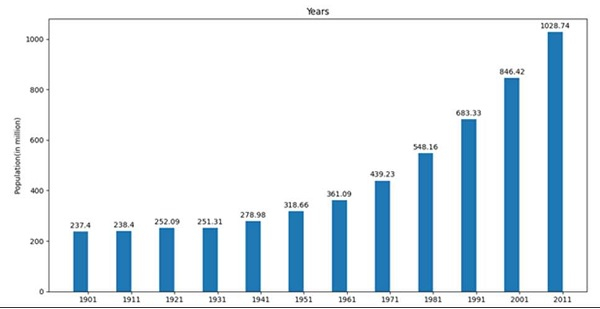
 Data Structure
Data Structure Networking
Networking RDBMS
RDBMS Operating System
Operating System Java
Java MS Excel
MS Excel iOS
iOS HTML
HTML CSS
CSS Android
Android Python
Python C Programming
C Programming C++
C++ C#
C# MongoDB
MongoDB MySQL
MySQL Javascript
Javascript PHP
PHP
- Selected Reading
- UPSC IAS Exams Notes
- Developer's Best Practices
- Questions and Answers
- Effective Resume Writing
- HR Interview Questions
- Computer Glossary
- Who is Who
Adding value labels on a matplotlib bar chart
In this program, we can initialize some input values and then try to plot a bar using those values. We can instantiate a figure and axis so that we could set the label, ticks, and annotate the height and width of the bar.
Steps
Make a list of years.
Make a list of populations in that year.
Get the number of labels using np.arrange(len(years)) method.
Set the width of the bars.
Create fig and ax variables using subplots() method, where default nrows and ncols are 1.
Set the Y-axis label of the figure using set_ylabel().
Set the title of the figure, using set_title().
Set the X-ticks with x that is created in step 3, using set_xticks method.
Set the xtick_labels with years data, using set_xticklabels method.
Make a plot bar using ax.bar().
Iterate the bar container (from step 10) to annotate to set the value for every bars.
Use plt.show() to show the figure.
Example
from matplotlib import pyplot as plt
import numpy as np
years = [1901, 1911, 1921, 1931, 1941, 1951, 1961, 1971, 1981, 1991, 2001, 2011]
population = [237.4, 238.4, 252.09, 251.31, 278.98, 318.66, 361.09, 439.23, 548.16, 683.33, 846.42, 1028.74]
x = np.arange(len(years)) # the label locations
width = 0.35 # the width of the bars
fig, ax = plt.subplots()
ax.set_ylabel('Population(in million)')
ax.set_title('Years')
ax.set_xticks(x)
ax.set_xticklabels(years)
pps = ax.bar(x - width/2, population, width, label='population')
for p in pps:
height = p.get_height()
ax.annotate('{}'.format(height),
xy=(p.get_x() + p.get_width() / 2, height),
xytext=(0, 3), # 3 points vertical offset
textcoords="offset points",
ha='center', va='bottom')
plt.show()
Output


